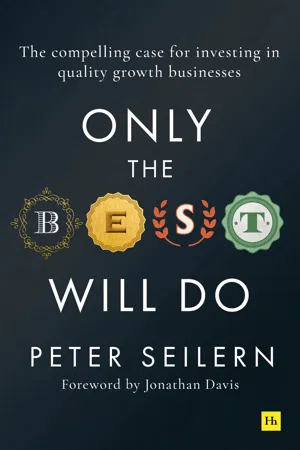Chapter 1:
Higher Returns and Lower Risk
Why is a strategy based on finding and holding a portfolio of quality growth businesses so attractive? As with any investment strategy, it ultimately comes down to balancing the two central elements of risk and return. Although the two are conventionally said to rise and fall in tandem, in reality it is not as straightforward as saying that more of one necessarily means more of the other. If it is possible to have an investment strategy which offers greater returns with below-average risk, any sensible investor, once aware of the possibility, would be foolish not to consider it. That in a nutshell is the happy combination which quality growth investing promises – and consistently delivers – to the investor.
Experience suggests that in practice most investors lack clarity about the need for a clear and considered strategy and are confused by the true meaning of risk. That is one reason why the returns they achieve are often disappointing. This includes professional as well as private investors. As is well-known, on average between 60 and 80% of professionally managed funds fail to beat an equivalent index fund or benchmark after accounting for fees.
The successful investor must make strenuous efforts to avoid the pitfalls of the majority. The investor needs to define what he wants, the time horizon over which he is willing to achieve it and the amount of risk he is prepared to take to get there. The more patient he is willing to be, the greater his chances of achieving success. When it comes to implementation, it is important that the strategy is capable of being implemented in a deliberate and dispassionate manner, free from emotional distractions.
Quality growth businesses, as we define them, are not normally regarded as a distinct asset class, but that is how in my view they should be seen, because they have a unique and distinctive set of characteristics. Most investors, if asked to name the most important asset classes in financial markets, will list public equities, private equity, bonds and other fixed income securities, currencies, commodities, real estate and collectibles such as works of art, classic cars and wine. Sub-classes such as corporate bonds, hedge funds and derivatives, to name the obvious ones, exist within each class.
The distinctive mantra of the quality growth investor is that only the best is good enough. His definition of quality and growth is detailed and specific. It means narrowing the field of potential investments to shares in a relatively small number of well-established and publicly listed businesses which possess a number of precise and positive characteristics. These characteristics include strong balance sheets, high returns on invested capital, market leadership in a growing industry, a sustainable competitive advantage and committed shareholder-friendly managements. (The ten most important criteria are described in more detail in chapter 3.) It is not enough to satisfy some of these tests: a true quality growth stock has to meet them all.
This makes those companies that pass muster an exclusive club. Out of 50,000 companies which are currently listed on leading stock markets, there are no more than around 60 which at any one time meet all the criteria that a rigorous quality growth investor such as my firm demands. These companies really are the crème de la crème. Their greatest strength is not just that they are well managed and profitable, but that, given sensible management, their profitability will also be consistent and durable. For the patient, long-term investor, they are the gift that keeps on giving. Few if any other asset classes offer quite such a powerful combination of positive attributes.
Just as important is that, contrary to conventional wisdom, a portfolio made up of this kind of investment will be inherently less risky than other types of investment, such as bank deposits and government bonds, which are traditionally thought to be at the lower end of the risk spectrum. To believe this does, however, require a willingness to think about risk and return in a different way to that presented in academic textbooks and in business school lecture rooms. In this chapter I consider both return and risk in turn.
Consistent returns
The guiding principle of investing in any business is that the value of its equity will ultimately be determined by the development of its profits over time. The gains that can be made by investors are driven by the growth in its sales and cash flows and by the return it can achieve on its invested capital. It follows that companies which can demonstrate exceptional quality on those measures must also in time deliver an above-average return to investors.
The empirical evidence confirms that this is indeed what happens. In the short term anything can happen in stock markets, of course, as prices bob around on a sea of sentiment and speculation, but the long-term pattern is clear. Companies with high returns on capital and consistent profitability, if purchased at sensible prices, are more rewarding as investments than companies with lower returns. They also produce higher returns than the stock market as a whole.
There is plenty of data to support this claim. A study by the American investment firm GMO, published in 2018, found that over the 90 years between 1928 and 2018 companies that scored highest for quality on a range of accounting measures produced on average a 0.4% higher return than the American stock market as a whole. If you added some strict valuation criteria on top – meaning refusing to pay silly prices for the best stocks – the advantage from investing in quality companies improved to 1.4% per annum.
On a first hearing 1.4% per annum may not sound a lot, but that is before one takes into account the wonders of compounding, the mathematical phenomenon which serves to turn even small percentage gains into big numbers over long periods. Simple calculations show that an investment portfolio which has a performance edge over the market of 1.4% per annum will be 10% more valuable after eight years and almost 50% more valuable after 30 years. In absolute terms, because of the wonders of compounding, the final value of a portfolio with these characteristics will be worth many thousands or even millions more than it would otherwise be, depending on the starting capital of the investor.
My experience in managing portfolios of high-quality growth companies also bears out the GMO study. Clients who invested 23 years ago in the Seilern World Growth fund that my firm manages have seen their money grow in value more than 523%, or 8.1% per annum, compounded. The fund has handsomely outperformed the MSCI World index by 247%, or 2.3% per annum, compounded over those two decades. The unit price of the same fund has grown 3.5 times in the past ten years alone, a compound rate of 13.2%, ranking it third in the universe of UK-registered global equity funds. (It is not an accident that the funds which rank in first and second place also manage money in a similar quality growth style.)
It is fair to make the point that the criteria which GMO uses to determine the highest quality companies, while similar, are not identical to the ones I describe in this book. In fact, our process is more demanding than theirs. Their survey merely took the one third of companies in the S&P index which scored highest on their quality measures. We insist on a tougher set of standards, and rather than taking a percentile of the top performers, make it an absolute requirement that they are all met. Our universe is therefore smaller, but the average quality of the companies in our universe is higher than those in GMO’s sample.
One would therefore expect that the margin of superiority in returns could also be greater, as indeed it proves to be. The table below summarises the potential impact of the higher growth rates that the quality growth companies in our universe enjoy, taking for this purpose return on invested capital (ROIC) as a proxy for the ten quality growth criteria we demand. The average return on capital for the 60 companies that qualify to be included in our universe today is 20% per annum. This compares to 11% per annum for the 500 companies that make up the S&P 500 index, the main US market index. (Note: this is the average profitability of the universe from which we choose our stocks, not the 25–30 companies which actually go to make up the current portfolio.)
It is important to note that the 9% per annum differential in the return on invested capital is not the only factor driving the superior return to shareholders. The payout ratio – the proportion of profits which are reinvested into the business each year – is also a significant factor. The power of quality growth companies stems not just from their high rates of return, but the ability to continue reinvesting their earnings at the same high rates of return. The average payout ratio of companies in our quality growth universe is 45%. For the S&P 500 index, the average payout ratio is nearly double that, at 79%. This helps to explain why at the start of any given period quality growth companies will have a lower dividend yield than the market, but consistently produce higher total returns over time.
Other important aspects of this analysis are presented in the next section, but the simple point to make here is that the higher return which the investor can reliably expect from a portfolio of quality growth stocks is ultimately driven by the demonstrable fact that they are making significantly more money and using capital much more efficiently than other companies. They are compounding machines and in due course both theory and experience tell us that such earnings power must and will translate into strong investment returns.
| Seilern Universe | S&P 500 index |
| Return on invested capital, 2018 | 20.0% | 11.4% |
| Payout ratio, 2018 | 45% | 79% |
| Dividend yield, 2018 | 1.4% | 2.1% |
| Total return per annum, 2008–18 | 14.5% | 12.8% |
Source: Seilern Investment Management
It is true that the price that investors have to pay to buy these stocks at any one time can vary enormously: sometimes they will look expensive and sometimes cheap. In the short term the relationship between the return on capital achieved by the company and the return on investment obtained by the shareholder will not be linear. The actual investment returns this kind of stock will deliver over any given period will be determined by the price paid on purchase and the price at the subsequent point of valuation. A disciplined approach to buying and selling is an essential part of the quality growth investor’s process. Even with outstanding companies, nobody wants to pay over the odds or sell them too cheaply.
Neve...

